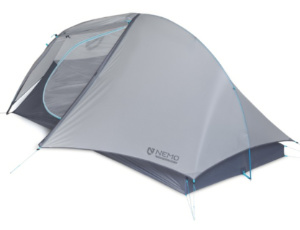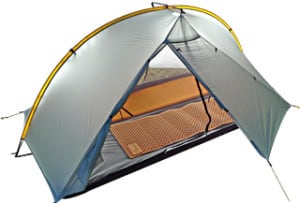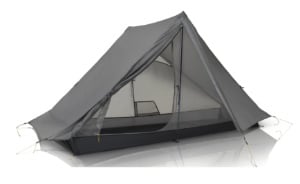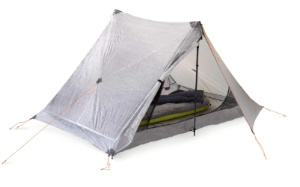
What are the best tents for thru-hiking? The first major option is choosing between a tent that comes with tent poles or a trekking-pole tent. Tents that have their own tent poles are usually easier to set up than trekking pole tents but often weigh more. Trekking pole tents utilize your trekking poles for the structure of the shelter, and are often single-wall, which means increased condensation. That said, there are plenty of hybrid shelters that mix and match the two as well.
| Make / Model | Structural | Trail Weight |
|---|---|---|
| Big Agnes Copper Spur HV UL2 | Tent Poles | 43 oz / 1219g |
| Gossamer Gear "The One" | Trekking Pole | 17.7 oz / 502g |
| Zpacks Duplex | Trekking Pole | 19 oz / 539g |
| Dan Durston X-Mid 1 | Trekking Pole | 28 oz / 794g |
| Big Agnes Fly Creek HV UL2 | Tent Poles | 31 oz / 879g |
| NEMO Hornet Elite 2 | Tent Poles | 27 oz / 765g |
| Zpacks Plex Solo | Trekking Pole | 13.9 oz / 395g |
| Six Moon Design Lunar Solo | Trekking Pole | 26 oz / 737g |
| Hyperlite Mountain Gear Unbound 2 | Tent Poles | 24 oz / 680g |
| Tarptent Double Rainbow | Tent Poles | 42 oz / 1191g |
You’ll also be considering the following factors: livable space, weight, durability, ease of pitch, and protection. When you take all of these into consideration, there is no perfect tent. If you’re opting for lighter weight, you’re probably sacrificing durability. If you want more livable space and protection, it’s likely a heavier tent.
Your best thru-hiking tent is the one that matches your hiking style. If you’re not an ultralight hiker, you probably won’t be happy with a minimalist tarp. Conversely, if you have a sub-10-pound base weight, chances are you aren’t carrying a freestanding two-person freestanding tent. Here are our top picks for the best thru-hiking tents to fit a variety of thru-hiking styles and preferences.
1. Big Agnes Copper Spur HV UL2
| Shop at REI | Shop at Backcountry |
2. Gossamer Gear “The One”
3. Zpacks Duplex
4. Dan Durston X-Mid 1
5. Big Agnes Fly Creek HV UL2
| Shop at REI | Shop at Backcountry |
6. NEMO Hornet Elite OSMO 2

| Shop at REI | Shop at Amazon |
7. Zpacks Plex Solo
8. Six Moon Designs Lunar Solo
9. Hyperlite Mountain Gear Unbound 2 (2P)
10. Tarptent Double Rainbow

Thru-Hiking Tent Selection Guide
Here’s a summary of factors to keep in mind when choosing your thru-hiking tent.
Freestanding tents vs. trekking pole shelters
These are the two main categories of backpacking tents, and there are pros and cons to both. Ultralight hikers are more apt to choose trekking-pole shelters, which are primarily single-wall units. These are held up by trekking poles, which the design assumes you already carry, thus no added weight of a pole system. These take some practice pitching: if they’re pitched correctly, they are very sturdy, but they definitely have the potential for poor pitches.
A freestanding tent or semi-freestanding tent, depending on how you define it, usually consists of a tent body and a separate rain fly. A separate set of poles creates the structure, and most of these models have to be staked out at the corners and fly for the best pitch. These tents can offer more resistance to condensation and a faster, sturdier pitch on a variety of surfaces, but they are typically bulkier and heavier than trekking-pole models.
Livable space and capacity
There’s a saying that gets thrown around with thru-hiking tents, something along the lines of: a two-person tent is one-person-plus-gear, and a three-person tent is a two-person-tent-plus gear. Just because you’ve hiked with a partner and used a two-person tent, it doesn’t mean you want to live in it with them for up to six months at a time. If you and your partner like to be able to sit up, spread your gear out, and stay away from the tent walls, consider a three-person model for your extended hike. Whichever size you choose, hiking with a partner means you should choose a model with two doors and two vestibules.
How much does weight-saving matter to you?
With very few exceptions, an ultralight shelter is going to compromise something else in the name of saving weight. It might be a single-wall trekking pole shelter that feels finicky to set up and collects condensation, or it might be an ultralight freestanding tent that isn’t as durable as other models. Thinner materials in ultralight shelters need more care, and ultralight poles have to be handled with care as well. A lighter tent might have less interior space, which can feel cramped in bad weather.
Before you go for the lightest shelter out there, consider your preferences as a hiker. You might take a compromise on weight but will end up with a tent best suited for yourself and your hiking style. That said, you don’t want to be carrying any more than a three or four-pound tent on your own. If you’re splitting a tent with a partner, both people shouldn’t have to carry more than two pounds each.
Durability and materials
This goes hand in hand with weight savings. Before you jump on the Dyneema Composite Fabric bandwagon, know that you’ll have to take extra care of the shelter should you go this route. DCF is the darling of the ultralight world, and it has a ton of benefits as a tent material. It’s taut, waterproof, and tear-resistant.
But the fact that it has no give means it can be prone to failure if stretched too much, and some earlier models of DCF tents tried to use too lightweight material, and the DCF tore on high-profile testing trips. If you know you’re hard on tents and you don’t usually carry a footprint, go for a heavier model, or at least something with a reinforced floor. Lighter models have thinner fly fabric and mesh also, with a tendency to get caught in door zippers. Be aware of this, and know that just because your tent cost an arm and a leg, it doesn’t guarantee it’ll stand up to continuous abuse over thousands of miles.
SectionHiker is reader-supported. We only make money if you purchase a product through our affiliate links. Help us continue to test and write unsponsored and independent gear reviews, beginner FAQs, and free hiking guides. SectionHiker.com Backpacking Gear Reviews and FAQs
SectionHiker.com Backpacking Gear Reviews and FAQs 






